Author: Tosh Lubek Published: 3rd May 2023
DIY Video Studio is supported by its readers who use the affiliate links or ads on this site. As an Amazon Associate, I earn from qualifying purchases. Thank your support if you use any of the links.
Most of the time the Fifine K688 USB/XLR podcast microphone will be used close to a computer, whether the USB or XLR output is used. But what if you’re away from your home studio and your only recording device is your smartphone?
No problem. If you can connect the K688 to your phone, you’ll be able to record audio.
To connect a Fifine K688 microphone to an Android smartphone use the supplied USB cable with a USB A to USB-C adapter or use a cable with USB-C connectors at both ends. To connect to an iPhone, use a Lightning to USB adapter or Lightning to USB 3 Camera adapter with the supplied cable.
Yes, it really is that simple.
I’ll explain exactly which cable and adapters I use to record with the Fifine K688 microphone on my Android smartphone and Apple iPhone. Plus, I’ll explain which are the best recording apps that have worked well for me.
To jump ahead to a step-by-step guide, with images, click here.
- [Clean Sound Quality] Featured with durability and adaptability, the XLR dynamic microphone for…
- [Upgrade XLR Output] XLR interface enhances the sense of audio space for immersive podcast audio….
- [Convenient USB Output] Provided with both USB and XLR connections, the USB dynamic microphone for…
- [Mute and Gain Control] Tap-to-mute on the USB mic front panel is handy to mute instead of pushing a…
Last update on 2024-03-10 / Affiliate links / Images from Amazon Product Advertising API
Can any phone record with the Fifine K688 mic?
I haven’t tested the Fifine K688 microphone with every smartphone with a USB-C port, but I have used it successfully with some Android phones and an iPhone. They are…
- Samsung Galaxy A20e (Android)
- Samsung Galaxy A52 (Android)
- Samsung Galaxy A53 5G (Android)
- Apple iPhone SE (iOS)
So, although I have had great success with setting up the K688 mic to record on these Android and iOS devices, I don’t guarantee it will work with every mobile device or that you will necessarily get the same results. Even so, my expectation is that it should work with most modern phones and tablets that have either a USB-C or Apple Lightning port.
If you’re reading this after Apple launched its first iPhone with a USB-C port, let me add a caveat. Apple is not renowned for making its devices 100% compatible with other tech. Hopefully, you will be able to record onto your iPhone with a Fifine K688 by simply using a USB-C cable. However, it is conceivable that some form of adapter might be necessary.
How to connect a Fifine K688 microphone to a smartphone
Although this is simple stuff, if you are unsure about how to proceed this section will hopefully help.
Apple iPhone
You will need the USB cable that came with the K688 microphone and an Apple Lightning to USB adapter or an Apple Lightning to USB 3 Camera Adapter, as you can see in this image.
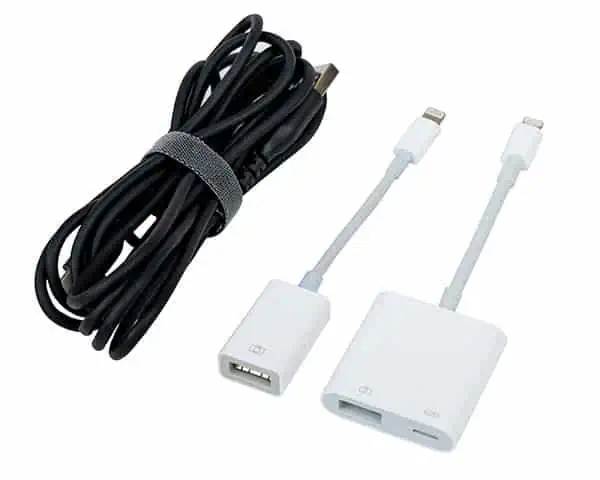
- Plug the microphone’s USB cable into the base of the K688 microphone.
- Then plug the other end of the cable into your choice of Apple adapter.
- Now plug the adapter’s Lighting plug into the Lightning port of your iPhone.
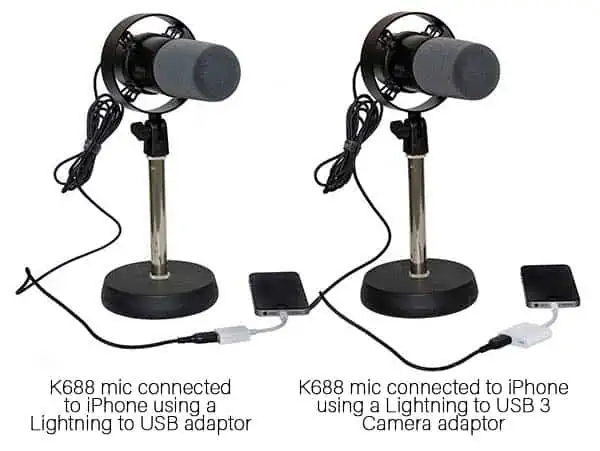
NOTE: This procedure should also work with an iPad. I have tried this with an older, and now unsupported, iPad 4 but it only worked with the Apple Lightning to USB 3 Camera Adapter.
Android phone
You will need the USB cable that came with the K688 microphone plus a USB-to-USB C adapter. Alternatively, eliminate the need for an adapter by replacing the original USB cable with a cable that has USB C plugs at both ends.
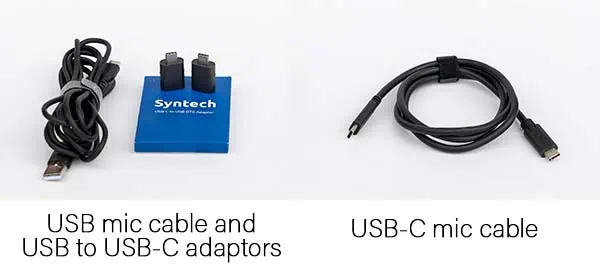
Method 1: Using the original USB mic cable and a USB to USB-C adapter
- Plug the microphone’s USB cable into the base of the K688 microphone.
- Then plug the other end of the cable into the USB-to-USB C adapter.
- Now plug the adapter into the USB C port of your Android phone.
- Open the recording app of your choice and proceed with a recording.
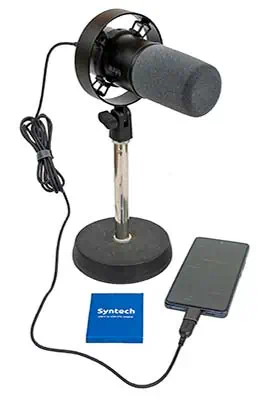
Method 2: Using a new USB-C cable
- Plug the microphone’s USB cable into the base of the K688 microphone.
- Now plug the other end of the USB cable into the USB C port of your Android phone.
- Open the recording app of your choice and proceed with a recording.
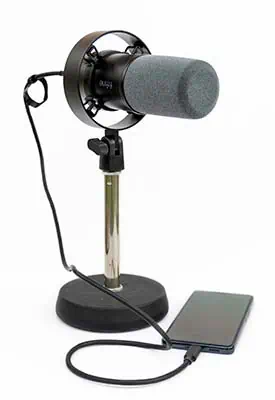
What accessories you will need to record onto your phone with a Fifine K688?
Whether you’re using an iPhone with a Lightning port, or an Android device with a USB-C port, you don’t need to spend much money on accessories to connect the K688 mic to your phone. Here’s what you’ll need, depending on the type of phone you have.
Apple iPhone: If you have an iPhone your device has an Apple Lightning port, so you will need either a Lightning to USB adapter or a Lightning to USB 3 Camera Adapter.
The latter has the advantage of providing both a USB port and a Lightning port, allowing you to charge your iPhone while recording. In both cases, you can use these adapters with the USB cable supplied with the microphone, which is USB-C at the microphone end and USB-A at the other end.
Last update on 2024-03-10 / Affiliate links / Images from Amazon Product Advertising API
NOTE: It is up to you which adapter you buy but I prefer genuine Apple products. That’s not because I am an Apple fanboy, far from it, but when I have bought third-party Lightning adapters they have not always worked as required.
Android smartphone: When connecting to an Android phone you have two options.
First, you can use the USB mic cable that came with the microphone, but you’ll also need to get a USB-C to USB-A adapter. The one I’ve used is the SYNTECH adapter. It works and it’s cheap. When I bought the adapter, I got a pack of two for $10, so that’s just $5 per adapter.
Your second option is to replace the USB cable that comes with the microphone with a cable with USB-C plugs at both ends. This is my preferred choice because it requires fewer parts and connections, and therefore fewer potential points of failure and probably less mechanical strain on the USB sockets.
If you are going to source the cable yourself, ensure that it can charge and transfer data. If it is solely a charging cable it will not work with the microphone. To save you time and effort, the cable I use is the UGREEN USB C to USB C 100W fast charger & data transfer lead. It has a 90° elbow connector at one end, which I plug into my phone, and a straight connector at the other end, which I plug into the microphone. Here is a link to the cable on Amazon.
- 100W Fast Power: The 100W USB C to USB C cable charges 52% faster than a 60W USB C cable, and its…
- Data Transfer In Seconds: USB C fast charging cable offers transfer speed up to 480 Mbps (USB 2.0)…
- Broad Compatibility: UGREEN USB C to USB C cable is compatible with iPhone 15/15 Plus/15 Pro/15 Pro…
- Upgraded Right Angle Design: The right angle USB C connector design is more friendly for you to…
Last update on 2024-03-10 / Affiliate links / Images from Amazon Product Advertising API
A further option is to use a USB C hub for USB-A peripherals that also has a Power Delivery USB C port. You will be able to connect the microphone to your phone while simultaneously providing power from a charger or power bank. I use one that is similar to this USB-C hub I got from Amazon.
- UL/SGS Approved Hiearcool USB C Hub: The intelligent USB C Adapter has perfectly combined all the…
- 4K HDMI to USB C Hub: The USB C Hub provides you with lifelike 4K 3840 x 2160@30Hz HDMI images that…
- 100W Power Delivery Supported: The USB C Hub supports a 100W USB C pass-through charging, ideal for…
- Efficient USB C Hub: Two high-speed USB-A 3.0 ports capable of 5Gb/s transfer speed for quick data…
Last update on 2024-03-10 / Affiliate links / Images from Amazon Product Advertising API
Mobile recording apps to use with the Fifine K688
Depending on what you want to record, you may not need any additional apps. For example, the camera app that comes with the iPhone or the Samsung Android phone will recognize the Fifine microphone and automatically switch to it, treating the K688 as an external/headset microphone.
Android Recording Apps
These are the recording apps I have used with the K688 on my Samsung A53 5G smartphone.
- iRigRecorder (audio & video)
- RodeRepoter (audio)
- ShurePlus MOTIV (audio)
- Samsung’s Camera app (video)
- MOTIV Video (video)
- Dolby On (audio & video)
- Open Camera (video)
All these apps work with the Fifine K688, and no doubt there are many others that you can download that will also work.
What I did find with these apps is that even though some are designed for other microphone brands, they recognized and worked with the Fifine microphone.
However, some apps are better than others. For example, with the ShurePlus MOTIV audio recording app, which is designed specifically for the Shure range of USB mics, the K688 had a very high input level and I had to substantially turn down the gain on the mic. However, the reverse was true of Shure’s MOTIV Video app. I had to turn the gain dial all the way up to get a reasonable level.
- For recording audio only, my top three apps are iRigRecorder, RodeReporter, and Dolby On.
- For recording videos (with audio), my top three apps would be Samsung’s Camera app, Open Camera, and iRigRecorder. I would have placed iRigRecorder first if it were not for the fact that it can sometimes be a bit flaky, including suddenly closing for no apparent reason.
iPhone Recording Apps
These are the recording apps I have used with the K688 on my iPhone SE and iPad and know that they definitely work.
- Native Apple Camera App (Video)
- iMovie (Video)
- FiLMiC Pro (Video)
- LumaFusion (Video)
- Voice Record Pro (Audio)
- GarageBand (Audio)
- ShurePlus MOTIV Audio (Audio)
Many of these apps are free, although FiLMic Pro and Luma Fusion are both quite expensive. LumaFusion costs $29.99 and includes in-app purchases. While Filmic Pro v7 is available under a subscription model, if you bought FiLMiC Pro v6 (now known as FiLMiC Legacy) prior to 25th August 2022 you can still download it.
For recording voiceovers or podcasts there are two clear winners for me. The first is Voice Record Pro and the second is ShurePlus MOTIV Audio. For music makers, the GarageBand app is the one I would choose.
In all cases, there were none of the variable audio level issues I experience under Android. With all the iPhone/iPad apps I tested the gain on the Fifine K688 needed to be at maximum and if the app had a gain slider it also needed to be set high. But to be fair, audio recording on my iOS devices was a better experience than on Android and I felt the results were better.
As I said before, I am NOT an Apple fanboy, but my experience is that the technology just works, and it does it well.
Can you monitor yourself with headphones?
The Fifine K688 has a latency-free headphone output on the base of the microphone. Plug in a set of 3.5mm headphones and you’ll be able to monitor your recordings as you go along and listen back without having to unplug the USB cable and plug in headphones.
Because of the number of dials and cables in a relatively small area at the back of the microphone, I find it a little awkward to adjust levels. Even so, once you’ve adjusted your mic gain and headphone level, you probably won’t need to do it again.
I have not tested using earbuds or other Bluetooth headphones. Even if they do work, they are likely to be impractical. This is because there will be a delay between you speaking and hearing yourself back. If you have ever tried to speak coherently while hearing yourself in delay, you will know how difficult (and very funny) it can be.
Solving the “attached accessory uses too much power” issue
When using any of my mobile devices with the Fifine K688 I never not got an onscreen message saying the microphone required too much power. However, I have not tested the K688 with every available device. Even so, I don’t think you experience this problem.
When I tested a Blue Yeti using GarageBand on my iPad I did get this warning but didn’t have the same issue with the Fifine K688. Therefore, I assume the K688 microphone requires less power than the Yeti.
But if you do experience the problem, you can connect the microphone to a powered USB-A hub. If using an iPhone or iPad you can use a Lightning to USB 3 Camera Adapter, since it includes a built-in Lightning port that can be connected to an AC power adapter or power bank. This will provide the extra power required.
Summary
If you are a mobile audio or video producer you can use the Fifine K688, whether you use iOS or Android devices. In some cases, you’ll need an adapter but if your device has a USB-C port you should be able to connect the microphone to your device directly using a USB-C cable. Monitoring your audio is often an issue for many people when recording with a mobile device. Fortunately, this isn’t a problem when using the K688. Because it has a 3.5mm headphone output on the base you can plug in headphones and enjoy latency-free monitoring.
Check out my review of the Fifine K688 podcast microphone here.
Here’s a big ask from me: If you liked this article, please share it.
It will mean a great deal to me if you share this post because a few seconds of your time will seriously help my blog grow. The share buttons are below the “About Author” section.
Thanks. 🙂
About the author: Tosh Lubek is a multi-award-winning broadcaster, writer, and video producer, with 40 years of experience in professional broadcasting and has been using Canon video and stills cameras since 2010. He has worked with radio and TV broadcasters, advertising agencies, and direct clients on a variety of projects including radio and television advertising, online video production, corporate videos, award ceremony motion graphics, and theme park sound design. Tosh has won numerous awards, including a Radio Academy Awards Gold Sony, a Gold, Silver, and Bronze World Medals in the New York Festivals International Advertising Awards. Since about 2007 he has been creating YouTube videos. Tosh has been a sponsor of the “video booth” at HashTag Business Events across the UK.
Recent Posts
Premiere Pro Editors STOP Dragging Clips WRONG! Edit 10x FASTER
Hey there, Premiere Pro users! If you're dragging your video clips from the project panel to the timeline listen up, there's a better way! The program monitor holds some hidden editing superpowers...
Conquer Your Next Media Interview Like a Pro! (With 15 Actionable Hacks)
Feeling anxious about your upcoming interview? Don't worry, we've got you covered! Whether you're a seasoned professional or a first-timer, mastering the art of the media interview can be daunting....








